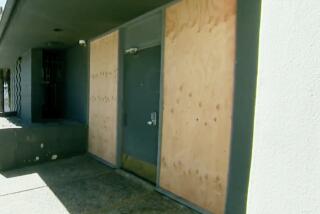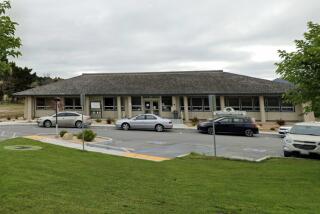California Journal: Is Junipero Serra’s sainthood a mixed blessing for Carmel-by-the-Sea?
Reporting from Carmel-by-the-Sea — The first act of vandalism occurred at the north end of town, on the day Pope Francis canonized Father Junipero Serra. The weekly Carmel Pine Cone reported that someone had poured black paint on a statue of Serra, and that a neighbor had cleaned it up within hours.
The second act, a few days later, was even bolder. On Sunday morning, worshipers coming to Mass at Carmel Mission were met with a distressing sight. A statue of Serra in the courtyard had been splashed with green paint and toppled. The vandals scrawled “Saint of Genocide” on the base and poured brown paint on a nearby grave stone.
“Your heart just absolutely breaks,” said Rico Tesio, an event manager at the Monterey Bay Aquarium who has belonged to the church for three years. “No different than waking up and seeing that done to my front door.”
I cannot say I found the crimes entirely shocking, or even unexpected. Every fourth-grader in California learns about Father Serra and the spiritual “order” he imposed on California’s native tribes.
Lots of us grow up and remember just one thing about his relationship with the Indians: the floggings.
“The floggings were terrible,” said Serra biographer Gregory Orfalea. “But this is a complicated situation and it requires a clear eye and an open heart.”
The punishment, he said, was meted out for theft, rape, molestation of women, or leaving the mission without permission. (That last is the very definition of oppression. On the other hand, Serra pleaded for leniency for Indians who killed a missionary in San Diego.)
Orfalea, who spent 13 years on “Journey to the Sun: Junipero Serra’s Dream and the Founding of California,” believes Serra’s sainthood was well-deserved, and that Serra should get credit for physically protecting Indians from Spanish soldiers and white settlers.
“Would that some of the Catholic bishops had acted as responsibly today as Serra did 250 years ago,” he said.
At Carmel Mission, part church, part museum and part Catholic school, you will find nary a dissenting word about Serra’s effect on tribal cultures, nor about that corporal punishment that has been seared into the memories of so many Californians.
I suppose that is to be expected, but some of the exhibits really strain to put Serra’s deeds in a good light.
In one, illustrated with excerpts from his diaries, Serra wrote in 1774 how he struggled to cope with the death of native children. “Two weeks ago,” he wrote, “over the course of a few days, eleven infants ascended to Heaven…. It was dysentery.” (Dysentery was unknown in California until the Spaniards arrived.)
His “compassion for the Chumash Indians” is demonstrated by a 1776 diary passage in which he extols two Indians for carrying him over muddy hills when he could not walk himself. “I was not able to repay them for their act of compassion,” he wrote, “And for me, this served to deepen the compassion I have felt for them for quite some time.”
Perhaps something is lost in the translation there.
::
As far as urban vandalism goes, the two anti-Serra incidents weren’t terribly dramatic.
But this is Carmel, where order reigns supreme. The tiny, affluent town is insulated by Pacific Coast Highway on one side, the ocean on the other, and a downright rigid devotion to its own adorable -- some might say strangling -- aesthetic and rules.
The city, for instance, limits the number of T-shirt stores, art galleries, wine tasting rooms and jewelers. The Pine Cone recently reported that the planning commission turned down a permit application for a chocolate shop -- too touristy.
Parking, already a hassle, is bound to get worse now that the town boasts its own saint.
Adding to its quirky charm, Carmel has no street addresses and no mail delivery. Mail must be picked up at the post office, forcing neighbors to socialize.
When I asked Carmel police commander Paul Tomasi how in the world authorities respond to emergency calls in a city with no addresses, he chuckled.
“Because we are one square mile, our response times are above average,” he said. “But it does make it tough. If you call from a residence, we can tell exactly where you are. If you call from a cellphone, we ask you what car is parked in the driveway, or what’s the name of the house, since most have a specific name. If you are at Xanadu, we know where it is.”
When the call came from the mission Sunday morning, the police responded quickly, but not quickly enough.
Well-meaning parishioners had already trampled the evidence.
“When officers showed up, there were 30 people in the crime scene cleaning up, which was wonderful,” said Tomasi. “But there were footprints and we couldn’t tell who they belonged to.”
::
Mayor Jason Burnett attended the canonization in Washington with his wife and 4-year-old son. The vandalism, he said, is “particularly disappointing.”
“This is not normal in Carmel,” he said. “The city’s role is to make sure we create a town square where all points of view can be heard in a safe way, and I think we have done that.”
Representatives of the Ohlone/Costanoan-Esselen Nation, who have a graveyard inside the mission walls and have opposed Serra’s canonization, disavowed the damage.
“OCEN has no knowledge of the destruction at the Mission,” said the tribe’s Facebook page. “OCEN’s events have always been peaceful and we have worked to protect our ancestors buried within the walls. This will not fall upon OCEN.”
The police have no suspects and no leads, but believe the crimes were political. Vandalizing a church, Tomasi said, is a felony.
The canonization, he added, “is bringing up a lot of emotions and concern. Someone is sending a message.”
Indeed. It is a message of anger, frustration and resistance. What would Father Serra do? Flog them? Or turn the other cheek?
I think he would forgive them. Shouldn’t we?
Twitter: @AbcarianLAT
More to Read
Sign up for Essential California
The most important California stories and recommendations in your inbox every morning.
You may occasionally receive promotional content from the Los Angeles Times.











